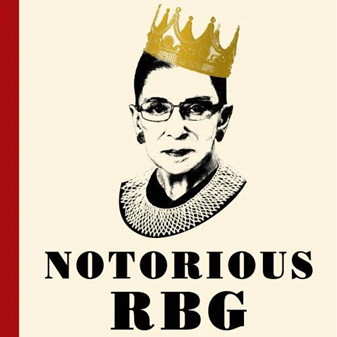The Notorious RBG

Photo Courtesy of Dey Street Books
October 16, 2020
America lost a central figure in U.S. politics on September 18th, 2020 at her home in Washington, D.C. At age 87, Supreme Court Justice Ruth Bader Ginsburg passed away from complications related to pancreatic cancer. Throughout her lifetime, Justice Ginsburg was known as a “crusader” for equality and women’s rights. Her legacy will not be forgotten by any factions of the political spectrum.
Justice Ginsburg became the second woman on the High Court when she was nominated by President Clinton. To display her importance she will be the first female to lie in state in the U.S. Capitol and lie in repose at the Supreme Court. Ginsburg worked extremely hard as a champion of equal rights and has a great background which coined her “the Notorious RBG” in a popular culture standpoint.
Ruth Bader grew up in Brooklyn, NY and was determined to succeed with the motivation her mother had who passed when Ruth was in high school. Ruth graduated from Cornell University, finishing first in her class. She would soon meet her husband Martin Ginsburg, a law student a year ahead of her. The two would go on to law school at Harvard, and Ruth was only one of five women enrolled. When Martin grew very sick, Ruth took the opportunity to take notes in his second year classes. Ruth would leave Harvard for Martin’s job and she would finish her Law degree off at Columbia University. Upon graduating first in her class, Ruth searched for a job at a law firm in New York, but as a woman in those days it was nearly impossible to get one. This would lead her to teach at Rutgers University and also lead the American Civil Liberties Union Women’s Rights Project.
Justice Ginsburg’s loved shaking up preconceived notions. Her concrete legal career began when she took on a gender equality case, however, not the traditional ones we are used to in modern times. Ruth and Martin together defended Charles E. Moritz before the U.S Court of Appeals for the Tenth Circuit. The Court held in favor of Moritz that that discrimmination on the basis of sex indeed does consitute a violation of the Equal Protection Clause. In the beginning, Ruth’s clients were often males to demonstrate that there was no difference between the two genders. Justice Ginsburg once said, “I would like to be remembered as someone who used whatever talent she had to do her work to the very best of her ability”.
Ginsburg would soon be nominated as a federal judge by President Carter in 1980. After her impressive time here, President Clinton nominated her to the highest court of the land in 1993 to serve for life. Some of her landmark case decisions included U.S. v. Virginia, Shelby County v. Holder, Bush v. Gore, and Stenberg v. Cahart.
A remarkable aspect about Justice Ginsburg was that she would work through most of her adversities. Multiple types of cancer, heart surgeries, and fractured ribs even her husband’s death in 2010 would not stop her from showing up to work the next day. She knew that her job on the bench and “radical” agenda was so far from finished as she famously said, “Real change, enduring change, happens one step at a time”.
Party lines did not cross Justice Ginsburg’s mind like most figures in politics. Despite their ideological differences, one of her best friends was Supreme Court Justice Antonin Scalia who had a more conservative depiction of the law. This was the character of Justice Ginsburg: she never fed into drama, always focused on her studies, and never closed anyone out because of their opinions.
Partisan divisions run rampant throughout the United States today. Perhaps the life and legacy of Justice Ginsburg may be the very thing that unites us?
But alas, the focus of the weeks following her passing have been filled with questions and utter gossip. The single most overwhelming question being: who will fill her seat on the Supreme Court, and when will it be filled?
One of the most important presidential powers is filling a SCOTUS seat when one is open. It may be even argued that Justice Ginsburg’s passing has become politicized and will take a front seat as a political issue in the 2020 election. President Trump, with support from fellow Republicans moved forward with the SCOTUS search. Joe Biden, with support from fellow Democrats believed that the SCOTUS seat should be “filled” by the voters and the winner of the election should hold that power.
Nevertheless, Justice Ginsburg’s seat will be replaced by Amy Coney Barret, but her legacy will not be forgotten. As a gender equality “champion” the words of Ruth Bader Ginsburg ring for a future generation, “Women belong in all places where decisions are being made. It shouldn’t be that women are the exception”.
